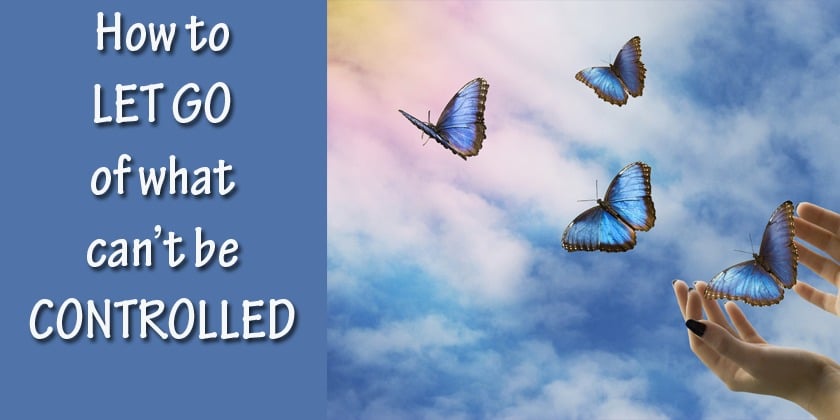The relationship you really wanted didn’t work out…
Your company is moving offices to a location much further away than your current commute…
You wanted to play on a sports team but you got injured and can’t…
Trying to get pregnant isn’t working out on the timeline you had hoped…
Have you experienced situations where you couldn’t change the course of events to get what you hoped for?
If so, you might keep revisiting it in your mind and feel mad, or sad, or thwarted. It can feel unfair, ‘why is this happening to me?’ It can feel demoralizing, “I don’t know how to go on if I can’t have ___”
How do you release emotional attachments to things you can’t change?
1. Identify how you are relating to the situation
When disappointed or grieving, you tend to focus only on what’s not working about your circumstances. You get into a spin cycle of focusing on how it COULD be only to remember how it IS, and then you are back in the loop of lack of control. It can be helpful to take a step back and have an awareness that ‘how you relate to the problem’ is now becoming a problem.
When facing any challenge, there are 2 ways of coping:
Problem–focused coping is the approach you use to change or resolve the stressful situation so it’s no longer a source of stress. If you can’t actually change the outcome, then you can also use Emotion–focused coping, which helps you manage the feelings and physical states associated with the situation, rather than changing the situation itself.
Often emotion-focused coping is about changing your physical feeling of emotion. Or about finding a larger context to shift the weighty nature of your emotional feelings.
2. Feel and then release the charge of your emotions – You can get stuck in the swirl of your emotions unless you move your emotions through your body. Instead of letting your emotions stagnate or build-up, use physical strategies to give expression to your physical states.
Start by allowing your self to feel the emotions you do have. Notice, where do you feel the sensations in your body? Is it sharp, or tingling, or like a rush? Can you allow yourself to feel it for a few seconds?
Most negative emotions come in waves, and each wave is said to last only about 90 seconds. If you can allow yourself to stay present with your emotions or allow your emotional experience to last for that time, you can expect to feel a little ease.
When you have intense emotions, it may even be too overwhelming to allow yourself to feel inside your body. It might help to put on a song that reflects your mood and allows your body to move ‘as if responding on its own to the music. If tears well up in your eyes, allow them to flow and have a good cry.
Explore other ways of expressing the physical nature of your emotions. I also love to beat up a boxing bag when I am angry, cuddle up next to a pet or a comforting furry blanket when I am mourning, or talk out loud to myself (or a trusted friend) when I am disappointed and trying to figure out my path forward.
Moving your emotions through your body will give you more clarity, and help you start to feel that the frustration and disappointment are starting to feel like ‘in the past’. It will open space for the possibility to see your future.
3. Look for the future silver lining – Even though the rest of the situation is inconvenient or painful, try to look past the negatives to see how there might be an opportunity for you to learn and grow. For example, my friend wasn’t able to adopt a baby for 3 years, and the adoption arrangements fell through twice. She was very upset each time it happened. After that grueling time period, she adopted a baby girl who is the light of her life. She realized that she would never have had the patience or financial security she needed as a parent if she had adopted earlier. In retrospect, she saw the blessing in her forced waiting period and wished she had that perspective instead of suffering through those years.
4. Distinguish “Form” from “Function“
You might have thought that your life needed to look like the original form you imagined. To open your mind to new possibilities, it can help to distinguish the “Function” of what you want (the underlying type of experience you want) from the specific “Form” it will take. For example, as a coach, the Function I want for my life is to help women overcome their private suffering so they can make the contribution they are capable of. I could fulfill that Function in many Forms, such as a school guidance counselor, a therapist, or even a Priest or Rabbi. These days my preference is to do this as an executive coach who helps women get promoted. But if that avenue was blocked for me, I could satisfy my underlying purpose in another Form.
Sometimes that means being open to evolving your identity. This obstacle might lead you toward a different (or even better) way of finding your purpose. For example, my friend trained to be an opera singer. She loved singing but got vocal nodes which ended her opera career. She identified that ‘having a voice’ was the through-line and the “Function” she wanted for her life. She followed that passion in whatever form it was available to her, first as a corporate trainer and now as a worldwide consultant on Inclusion. She had to be open to changing her identity from Entertainer to Educator.
5. Identify the “real reason” you have an attachment to the outcome. Usually, the real attachment to the outcome can be found in “why” you want that outcome. Often you are trying to experience something inside of you that you are attributing to getting from outside of you.
For example, my friend is a well-known entrepreneur who was trying to have a relationship with a narcissistic man. She worked too hard to ‘get his love’: She dressed up in outfits that were beyond her means, and she supported his career at the expense of her own. At first, she couldn’t ‘let go’ of trying to get his love, even after she realized that he was so wrapped up in himself that he was incapable of loving her. Why? Because she was hoping that if she could get him to say he loved her, then she was “loveable”. She could only release her attachment to him, along with all the wasted mental energy, once she was able to start to value herself. Then she no longer needed to see herself through his eyes, she could see herself through her own.
Similarly, if you were in a relationship with someone who had a sunny disposition but you are someone who tends to live in scarcity, you might think that the only way to have a positive and abundant life is to still be with that person. But that’s just a short cut or lack of confidence. You could grow to have that sunny feeling from your own life or within yourself.
The insights in this article are, in part, the opinion of the writer.



